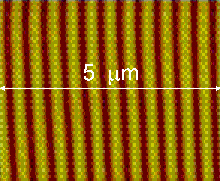Feb 19 2011
A team working at Princeton University has developed a sensor to determine the condition of a building or a bridge at a glance. The organic laser on a rubber sheet stretches when a crack is developed while the alarm light changes color.
 Princeton's Strain sensor
Princeton's Strain sensor
A sheet of the stretchable fabric called polydimethylsiloxane (PDMS) was developed to offer a wavy surface. A liquid mixture of organic molecules was poured over the sheet. A UV laser beamed on the organic layer, following a method of powering an optical pumping laser, causing an emission of photons from the organic particles. When light is refracted between the waves, enhancing the signals it becomes a sensor.
According to Jerome Lynch, professor of civil and environmental engineering at the University of Michigan, this sensor will address a crucial requirement of the engineering and construction segments, by warning of potential risk of bridges or buildings collapsing. A normal strain sensor can detect stress only along a straight line, making it difficult for strain to be tracked between the sensing devices.